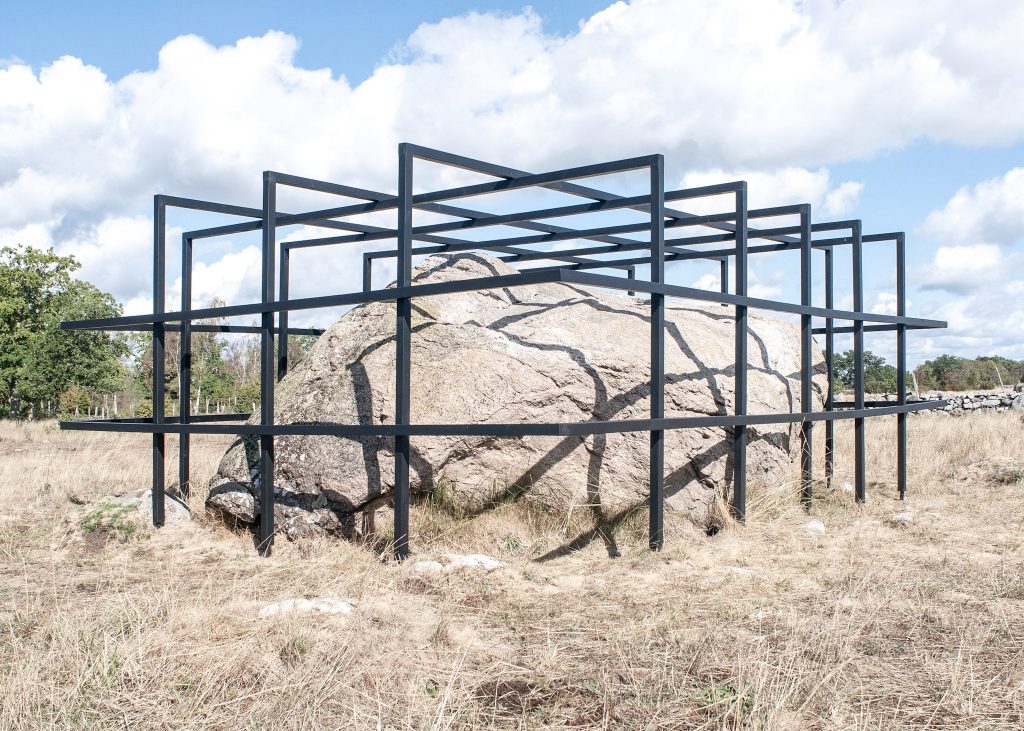with VOGEL’S NET
an artwork by PAIGE SILVERMAN
Lately, I’ve been feeling that I am deteriorating as a therapist. It’s supposed to be the opposite: there is an axiom in psychotherapy, probably like in any other profession, that we become better with time, that training and experience make us better therapists. I was always skeptical about the time x skills equation and spent many team meetings wondering whether the best therapist in the room was actually the least experienced one. And now, only five years after graduating, I am starting to think that I am becoming worse.
To be a novice is to be fallow, not affected by acculturation forces (explicit and implicit) that change the way we think, talk, and behave by the systematic dissemination of professional seeds. Therapists are not born hmming in conversation, they become someone who hmms.
Throughout my training I consciously resisted our professional acculturation, refusing to become a stereotyped therapist who talks and sighs like a therapist, who sits like a therapist and nods like a therapist. I became slightly proud of this stance: I don’t care what some (most) of my colleagues do, I’ll resist the therapeutic cliche with all my might. I won’t use jargon, I won’t be neutral, I won’t be silent, I won’t talk differently in the room. “Above all else be human, that’s what’s therapeutic” has been the motto, which, in itself, is obviously also a cliche.
As many other students of psychotherapy, I began seeing patients early in training. In my graduate school in New York, it worked like this: first year you’re starting to administer psychological tests and conduct intake sessions (some of which are observed by a team of other students and a professor), and during the second year you start seeing patients. So I became a therapist after two semesters of learning about different types of psychotherapy, different techniques of intervention, different models of the mind, of development, of psychopathology, etc. I was twenty-eight and naturally felt completely inadequate. I believed, rightfully I think, that I hadn’t lived enough, hadn’t seen enough, hadn’t studied enough to be someone else’s therapist. From what position of authority, I wondered, was I making suggestions or interpretations?
The first person I met in our student run community clinic was about my age, a few years older. We met only for a couple of sessions and I barely remember him. But I distinctly remember the feeling of confusion and awkwardness I experienced talking to him.
“How does this work?” he wondered.
“What work?”
“Therapy.”
Tensed, focused, trying to sound professional, I summarised the two semesters worth of wisdom with something like: “Some people find it helpful to open up to someone else . . . Verbalizing our experience has been shown to be effective . . . There are different skills we can learn together to help you with your depression . . . Tell me more about what you mean by ‘works.’” Things like that, which were all reproductions of something I heard other therapists say, a regurgitation of therapeutic truisms.

For me, the reason for saying these things in a ‘professional’ (i.e., detached and formulaic) tone was a belief that I had to at least act like a therapist because I didn’t really feel like one, that I had to put on a therapist persona because otherwise the patient would discover that I was a fraud, someone who just started out and had no idea what to do. Speaking and behaving like a caricaturistic therapist is common among novices and is a result of insecurity: trying to hide inexperience by imitating what you believe a ‘real’ therapist would do, would say. With time, I developed a therapeutic style that was a rejection of such a mechanistic, jargonized manner of speaking. Now I understand that this rejection came with an unexpected price.
Being tense there in the room was, in retrospect, a good thing. It was therapeutic. Feeling inadequate propelled me to action: I was constantly thinking about how to reach Simon utilizing everything that I had learned. I was on my toes, I was sharp, but I was not confident. As he was talking to me, I constantly tried to make sense of what he was going through, what it meant, and what I should do about it. The novelty of the situation, being a very young therapist, allowed me to be in a conscious state of not knowing, not judging, just scrambling to offer him something, do something for him. I didn’t have a grand structure or a vision of what we were doing together and where it was all going. As a result, each session felt fresh and exciting. I couldn’t compare Simon to previous patients, I couldn’t say things like “ah, classic masochist.”
In my attempt to find authenticity and reject jargon, I embraced the rejection itself as a guiding principle. If other therapists were centering their work around a particular type of therapy (“I am an ACT therapist”) or theoretical orientation (“I am relational”) or a specific thinker, and thus transitioning from fallow novices to professionals, I positioned myself as ‘authentic’—I will be the same Valery in the room as I am outside of it. I’ll bring into the room everything I can from the outside, if it can help someone feel better. I will blend the two worlds and reject the robotic professionalism I tried on for a moment as a novice.
So the dialogue with Simon by my more mature therapist-self would sound something like this, I imagine:
“How does this work?”
“What?”
“Therapy.”
“Oh . . . I don’t know. No one knows.”
(Simon is hopefully laughing). “Shouldn’t you know? Isn’t it part of your job?”
“It is . . .”
“So??”
“It’s a question I’m asking myself all the time.”
“I would like to know the answer!”
“There are different answers. There’s research I could probably cite. There are some ideas about opening up and its benefits. There’s the whole thing about the unconscious—how we do things we are not aware of, how we are governed by forces outside of our awareness, and how bringing them to awareness might be beneficial in stopping their influence. This never felt enough, though. Not that it’s not true, it probably is, but look at us: here we are, struggling, trying to figure out a better way for you to live, to feel better about yourself, the world. Is there a formula? A ‘skill set’? I don’t think so. But in this struggle, I’ll try to use everything I know, everything that I think might resonate. Maybe it will help.”
My problem was that over a relatively short period of time (a few years) I became quite confident in my ‘authentic’ rejecting-all-formulas approach, and, maybe, fell in love a little bit with the image of a therapeutic rebel. Patients connected to this no-nonsense approach, and most of them, it felt to me, found it refreshing. In my private practice, for example, people who came for a first session typically stayed. The feedback I have been getting from patients was generally positive, and I had many indications that I was doing something right. But my tense, caricaturistic self was so much better at embracing the unknown, constantly searching for answers and never assuming I ‘got’ someone, being humble. The more comfortable and confident I became, the looser I became, missing where my patients actually were, assuming that I knew. Confidence in our therapeutic approach, I believe now—even if that approach is ‘I never have an approach, that’s the approach’—is problematic. It might make us less effective because the therapeutic ingredients of deep curiosity, activity, fight, and humility—which might be what psychotherapy is all about—are in danger for someone who is relaxed, comfortable, and confident. Maybe insecurity is therapeutic? Maybe it’s better to be a fallow therapist than a seasoned one? Maybe it’s better to be trembling a little when talking to someone in pain?
A recent example.
I have been working for several months with a man in his mid-twenties who came to see me after two difficult breakups. He said that he had been depressed and had seen about ten therapists throughout his life. “Great challenge,” I thought to myself, “let’s see if I get him.”
We had an easy, natural initial connection. It felt as if we were speaking the same language, and in my mind I had a meta-structure that explained, generally, his problem and indicated a possible way out. Let’s call it a theory of mind. I thought that it was precise enough, that is, close enough to explaining the reasons for his suffering, and I started communicating it to him, trying to make him buy into that.
My younger, fallower self would have been tentative. Curious about Brian’s depression, uncertain about the reason for the breakups, hesitant about drawing conclusions about his relational patterns. Maybe using a jargony word here and there, maybe looking up a relevant article. But my more mature self felt a little over it. I had a structure, a formula I believed in, and therapy was mostly about getting Brian on the same page, communicating to him that: “Yeah, of course you experience this, it’s completely normal and expected. I’ve seen it many times.”
Few sessions went by (pretty well I had thought) before he told me that I wasn’t really helpful. There are many ways to examine what happened between us, in our relationship, the potential similarity of the endings with his previous therapists. But fundamentally, I thought that he was right: I wasn’t helpful. Reflecting on our work, I realized that above all else, and despite there being so many reasons for any kind of change happening in, and through, therapy, the biggest problem was that I had become confident—that therapy became about convincing someone of something and not about a desperate search for a moment of reprieve, for a flickering light that for some strange and unexplainable reason was what we were looking for without knowing. Never would have happened to a therapist who still lay fallow.


VOGEL’S NET
Does the failure of an object to perform, in itself, perform a function? How does one justify the failure of an object with its will to exist as a failure? (For controlling objects through their actions, whether intended, debunked, etc., still predicts a pattern/model of their use). Does absurdity live solely at the peripheries of memory?
VALERY HAZANOV writer
Valery Hazanov holds a doctorate in clinical psychology from Columbia University and is the clinical director of headspace Jerusalem, a psychology treatment center for youth. He is the author of The Fear of Doing Nothing: Notes of a Young Therapist, a book about a skeptical trainee in New York City on a quest to discover the essence of psychotherapy in an ocean of psychological jargon and unrealistic (always neat, almost always successful) depictions.
PAIGE SILVERMAN artist
Paige Silverman (b. 1990, Los Angeles, CA) is currently a MFA candidate at Glasgow School of Art in Glasgow, Scotland. She received her BFA from Rhode Island School of Design in sculpture in 2012. Silverman’s work attempts to negotiate the warped role of the human hand on our earth, playing with vulnerability and absurdism in materials and objects traditionally associated with force and power.
VOGEL’S NET (2018): Installation image from Land404 Residency exhibition At Last The Perfect Weather is Unending in Gullholma, Sweden.
350.52 x 487.68 x 177.8 cm
Steel & wood, wooden dowels, paint, screws, and joint compound.
Image credit: photographs by Simone Alexandra.
© Copyright for all texts published in Stillpoint Magazine are held by the authors thereof, and for all visual artworks by the visual artists thereof, effective from the year of publication. Stillpoint Magazine holds copyright to all additional images, branding, design and supplementary texts across stillpointmag.org as well as in additional social media profiles, digital platforms and print materials. All rights reserved.



